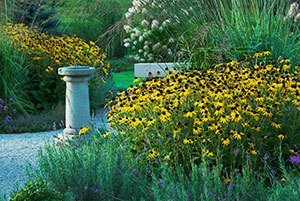In the early fall garden, the air is cooler and fresher – what a relief this is if you get a lot of high humidity over the summer!
But, sadly, the days are getting shorter and the first frost is looming. Still, if you’ve planned your garden well, you have late-blooming perennials such as sedums, asters, mums, and ornamental grasses to enjoy.
And in northern areas, gorgeous fall colors are on the way. As the season winds up, there’s plenty to do in garden.
Early fall garden jobs: In the yard

Watering: One important job in the early fall garden is to continue to water your plants, especially your evergreens and trees and shrubs if it isn’t raining enough.
Going into the winter well hydrated will help keep your plants thriving. More on winterizing trees and shrubs.
Move woody plants: This is can be good time of the year to transplant any shrubs or small trees that you have earmarked for relocation. Do this when the leaves of deciduous woody plants turn color and start to drop.
Plant trees or shrubs: In many regions, particularly mild winter areas, this is a good time to get woody plants into the ground. See tree planting instructions. (Find out more about the pros and cons of fall planting.)
Lawn care: Aerate your lawn and reseed any dead or thin spots. This is the best time of the year to lay sod, overseed or start a lawn from seed because temperatures are cooler and rain tends to be more plentiful than in the hot summer months. More lawn care tips.
Create a new bed: Do soil preparation for any new beds you want to have ready for spring planting.
Landscape projects: This is a good time to plan or do landscaping projects, such as walls, walkways, patios, and decks. See landscape design tips.)
Early fall garden to-do list:
In the flower garden
Container plantings: Once they’re past their prime, empty containers of annuals and store frost-sensitive containers in the basement or the garage.
Perennials: Don’t be in a great rush to cut back all your perennials early. Seed heads and foliage that’s coloring up can be beautiful, and the seeds are food for migrating birds. Just cut back plants that are diseased, those looking past their prime, or those that may become “weeds” if allowed to self-seed freely.
Late season gaps: If you have too little color in the garden now, visit your local garden center for some ideas on late-season flowers to add, and take advantage of end of season sales.
Plant or transplant perennials: Divide overgrown perennials—this is the ideal time to divide and move peonies and Siberian and bearded irises.
Deal with spent annuals: Pull or dig out summer annuals that are past their prime, and plant mums and colorful kale for fall interest. Find out how to over-winter geraniums.
Dig up summer bulbs if you want to keep them. After the first frost, dig up dahlias, cannas, gladioli, and similar non-hardy bulbs for winter storage; see how-to tips.
Garden planning: Make notes about garden changes or plants that you might want to move in the spring.
Think spring bulbs: Buy spring-flowering bulbs while they’re in plentiful supply, but don’t plant them too early.
More Fall Gardening
Is fall planting of perennials and trees and shrubs really a good idea?
Fall mums perk up late season flower beds and containers
How to collect and save seeds from your own garden
Get your garden ready for winter
Perennials and grasses for the late-season garden





